NYC Is Full of Echoes From the Ottoman Empire
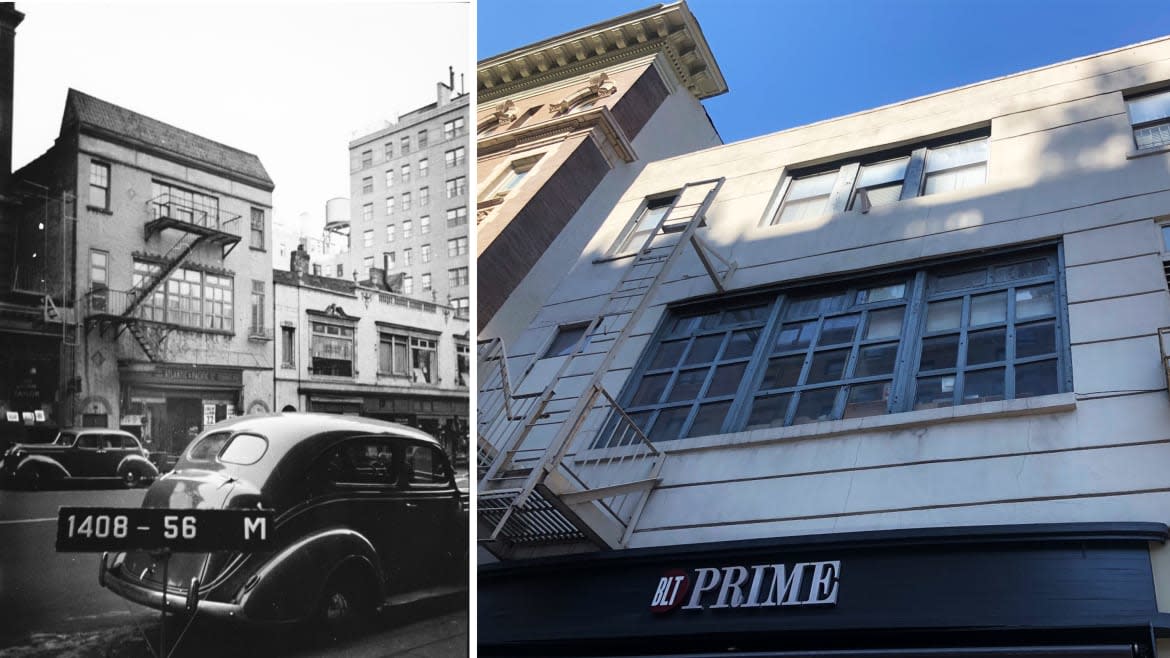
There is a building on Lexington Avenue in the 70s that’s easy to ignore. Its facade is three stories of rain-streaked beige in a sea of taller apartment blocks and tonier shopfronts. A slate-grey door with a faded gold mail slot hides in a recess on the ground floor. Its intercom has four buttons, three of which are covered with tape. The fourth, however, is shiny white from use. A yellowed slip of paper next to it reads, in elegant if faded capital letters, “OSMAN.”
Osman was the name of the founder and first Sultan of what would become the Ottoman Empire, its very name a permutation of the word Osman. He ruled in the late 13th century and was followed by a string of successor descendants, each of whom strengthened and expanded Osman’s holdings. Perhaps the Ottomans’ most famous achievement came in 1453 with the sacking and capture of Constantinople. This was the last stronghold of the Byzantine Empire, the Eastern Roman world. Along with Rome, it was considered one of Christendom’s two eyes. In 1453, by capturing Constantinople, the Ottomans plucked one eye out, sending shockwaves through the world that Islam was officially in its ascendancy.

Europe spent much of the next century spiraling into a new reality, one in which the threat of Ottoman power loomed ever larger and more menacingly in the east. Fear of the Ottomans lurked behind virtually every decision made and action taken by European kingdoms of this era. And the Ottoman Empire survived, somewhat intact, until after World War I, more than six centuries of unbroken presence on the global stage. So why do the Ottomans not play a more central role in our usual telling and understanding of world history?
This question is central to a new book, God’s Shadow: Sultan Selim, His Ottoman Empire, and the Making of the Modern World, by Alan Mikhail, Chair of the History Department at Yale University. The book focuses on the life and times of Selim I, “Selim the Grim,” grandson of the Sultan who conquered Constantinople in 1453. Selim reigned from 1512-1520 and oversaw the largest territorial expansion in the empire’s history, consolidating much of the Sunni Muslim world under one rule for the first time in history. Mikhail, in magnificent detail pulled from a global network of archives, makes the case that no telling of world history is complete, or even adequate, without including the achievements and influence of the Ottoman Empire.
Alan was kind enough to meet me recently for a walk around Manhattan. The plan was to walk five miles, visiting five sites with Ottoman ties, proving the vitality and endurance of the Empire’s influence, even a century after its dissolution. We met on West 51st Street, in Hell’s Kitchen, at a small coffee shop called Kahve. The word “kahve” itself is symbolic, as it’s the Turkish word for “coffee.” The Ottomans didn’t invent coffee, Alan explains, but they did invent the concept of the coffee house, of a place to go and drink coffee in an egalitarian social setting.
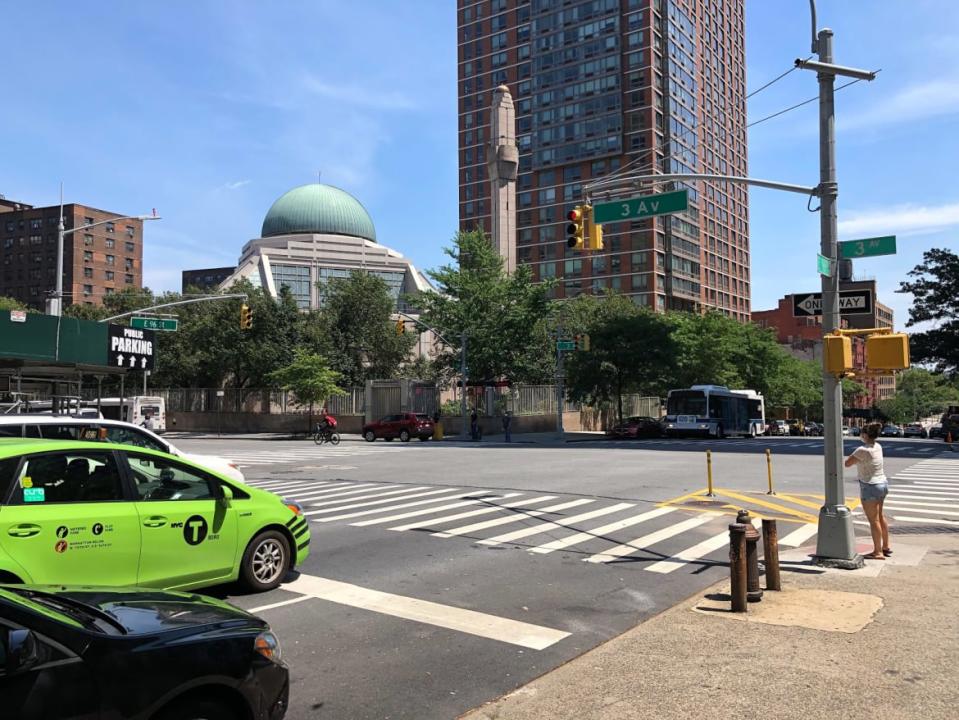
One of the results of Sultan Selim’s conquests in 1516 and 1517 was that the semi-autonomous territory of what is now Yemen came under Ottoman control for the first time. Yemen was, and is, the native home of the shrub “Coffea arabica,” or Arabian Coffee. Roasted and brewed locally in Yemen for centuries, it wasn’t until the area came under Ottoman control that coffee was plugged into global trade networks. The Ottoman-Yemeni port city of Mocha dominated the global coffee trade for the next two centuries, producing 90% of the world’s supply through the late seventeenth century. It wasn’t until the 1720s that Dutch growers on the Indonesian island of Java overtook them.
Regardless of the origin of the beans, coffee wouldn’t be the cultural, social, and gastronomic staple that it is today were it not for the Ottoman Empire and its invention of the coffee house. Coffee was initially served in taverns, Alan says from beneath a blue mask, along with wine and other vices, giving it an air of the taboo. The coffee house was also a place where men of all ages and social ranks could mix and converse freely. Similar to the traditional bath house, the coffee house gave Ottoman men a safe space to mix, converse, and debate among fellows without the pretense of the outside world. Ottoman poetry is rife with odes to the seductive women and young serving boys who worked in these establishments, adding to their forbidden mystique.
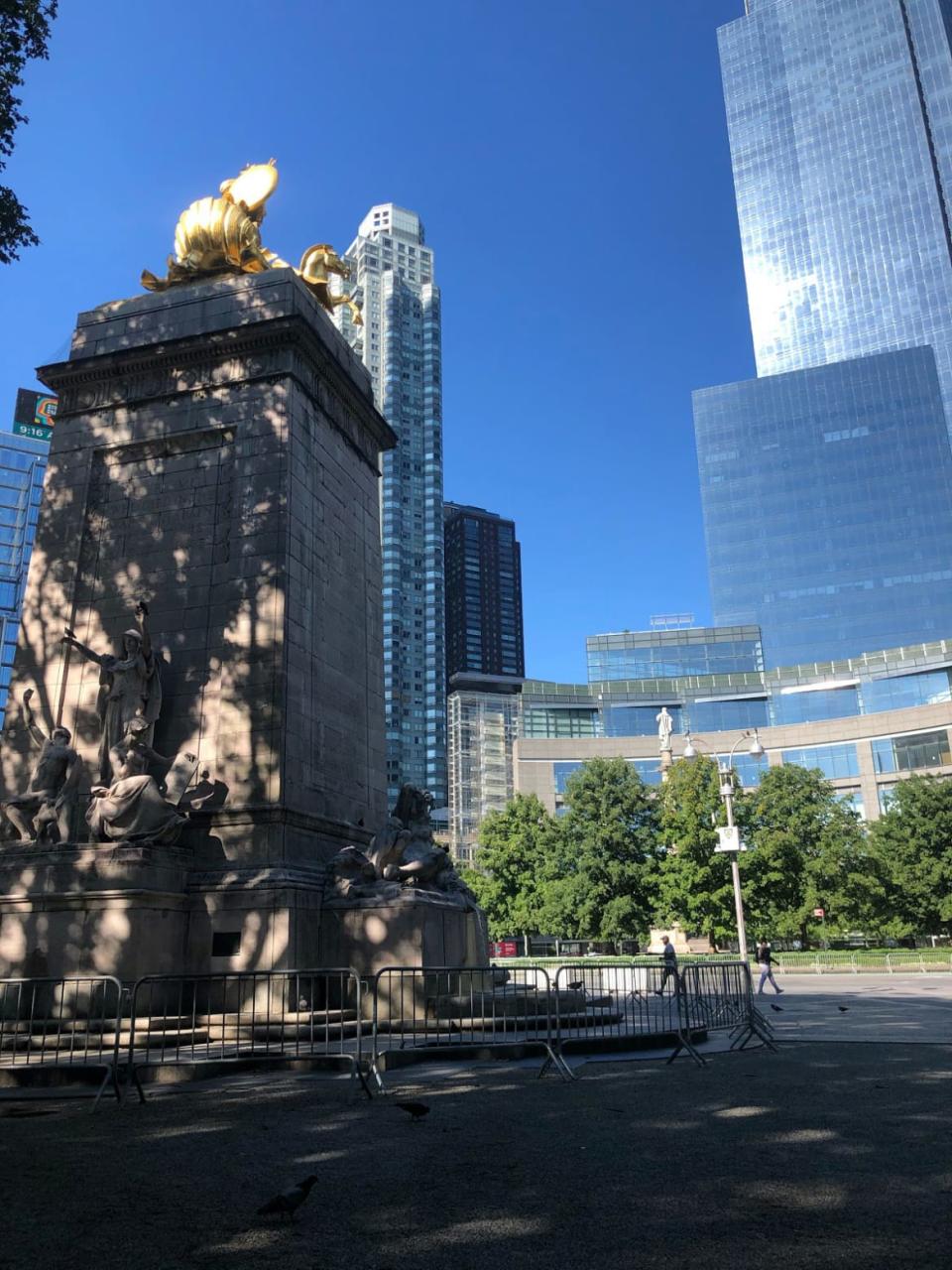
Coffee, once a regional specialty of the southern Arabian peninsula, was popping up around Europe by the 1580s, in coffee houses like those experienced by travelers to Ottoman lands. “The farther away from Turkey coffee went, the lighter it got,” Alan explains as a general rule for determining how long of a path the drink took to reach a particular city or society. Turkish coffee is drunk nearly black. Venetian and Viennese coffee is similar, but a bit more diluted. Move farther from the source, and you begin to find coffee lightened by milk and water and sugar. It’s a liquid trail leading back to coffee’s origins. Today there are more than 3,000 coffee shops in New York City alone, a tangible if forgotten testament to the centuries-old influence of the Ottoman Empire.
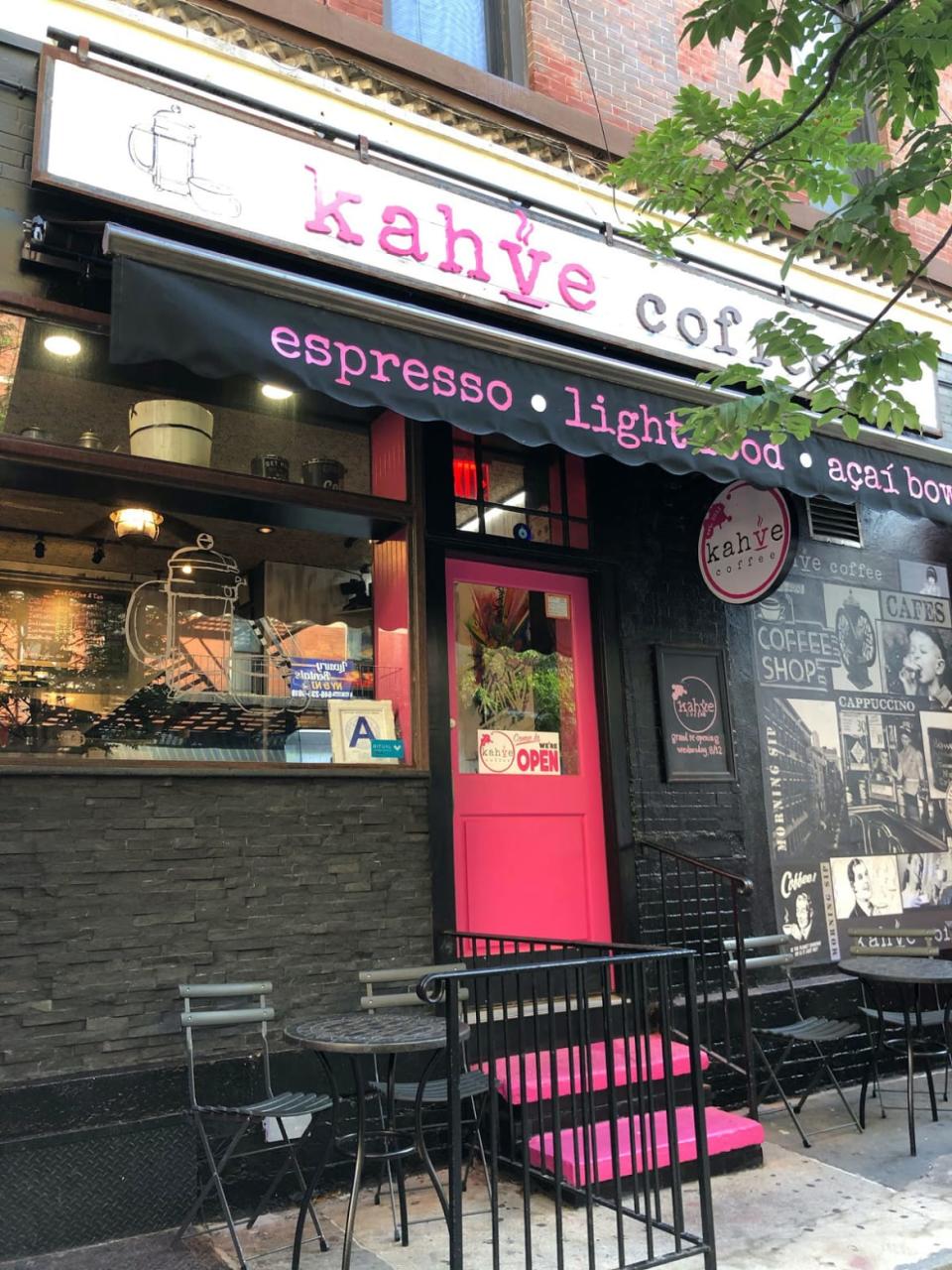
We left Kahve, coffees in hand, heading north toward 59th Street and the next stop on our Ottoman journey. There, at the southwest corner of Central Park, stands a 76-foot-tall monument to a Genoese sailor whose bumbling misadventures on the westward seas changed the course of world history. Christopher Columbus was born in 1451, just two years before the Ottoman capture of Constantinople, so he would’ve grown up hearing the stories and feeling the anxiety associated with this seismic event in Christendom, as many Europeans felt the Apocalypse was imminent. Alan’s book draws the connection between Columbus’s inherent anti-Muslim sentiment and his quixotic journeys west in search of an oceanic path to Asia, as direct results of his having grown up in the shadow of the Ottoman Empire’s rise.
“Genoa, his home town, is a port city where the merchants have a lot of connections to the Black Sea and the eastern Mediterranean that they lose in 1453, so there’s this sense of loss in the city,” Alan continues as we sit on a bench at the edge of Central Park overlooking Columbus’s statue. “It’s also a Crusader port, so he would’ve been very familiar with crusaders and merchants moving east.” Alan goes on to explain that Columbus grew up reading Marco Polo, who wrote of a “Grand Khan in some vague place in Asia that has interests maybe in converting to Christianity and then helping European Christians to destroy the Muslims in the middle.”
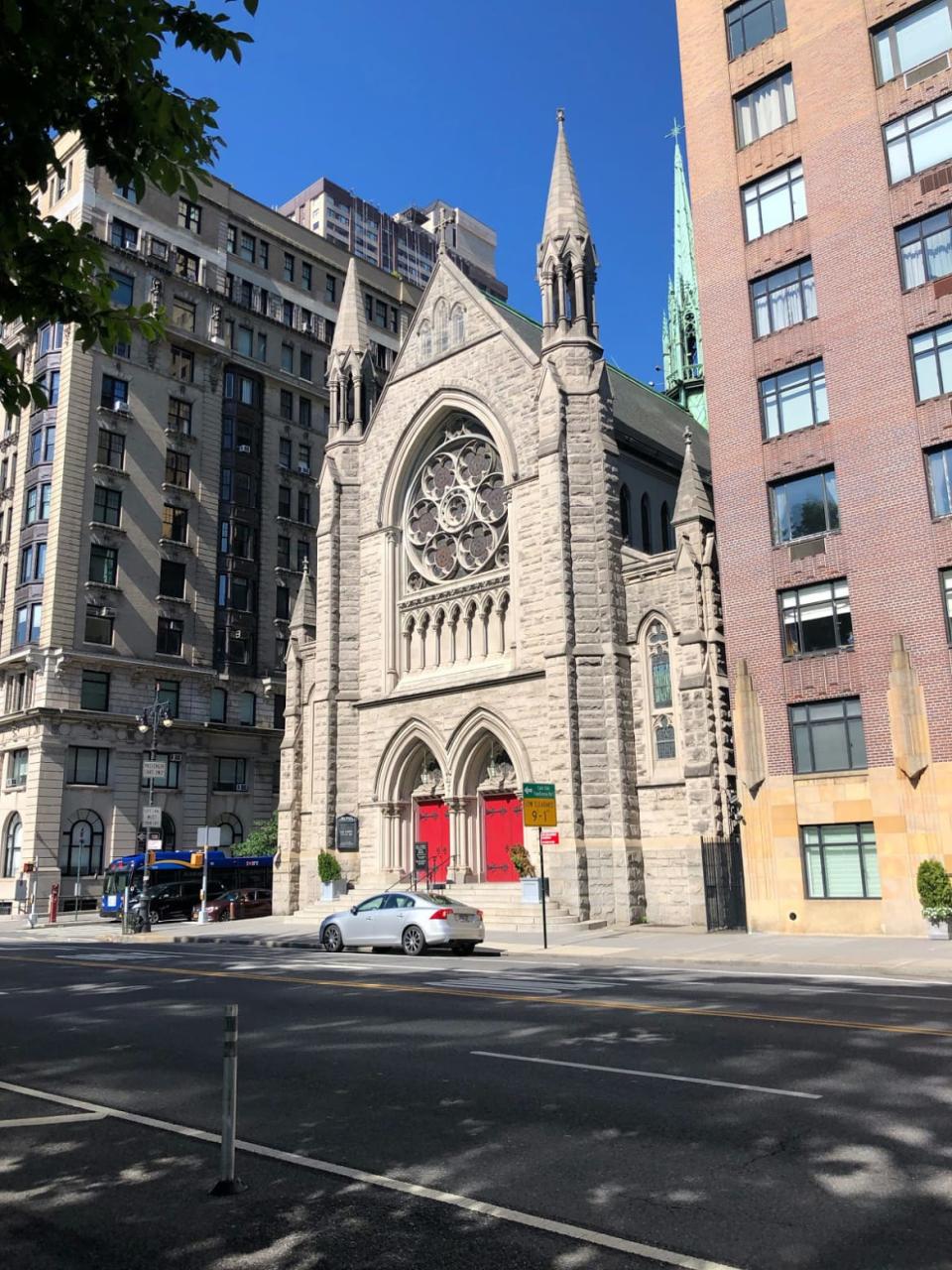
Columbus took to the sea as a teenager, visiting ports in the Mediterranean and along the coast of Africa. Constantinople had just fallen, and it seemed as if everywhere Columbus sailed, he encountered yet more proof of Islam’s global reach. “So this sense that Islam is this foreboding, encroaching thing moving on Christendom is something that embedded in the psyche, and I think is key to understanding everything that he does afterwards,” says Alan, adding that Columbus’s true intent in sailing west was to find Marco Polo’s “Grand Khan,” win him as an ally for Christendom, and defeat the Muslim threat once and for all.
“In fourteen hundred ninety-two,” the rhyme goes, “Columbus sailed the ocean blue.” But 1492 was also the year that Spain, under Queen Isabella and her husband Ferdinand, defeated the last Muslim stronghold in Iberia, at Granada, and began the process of expelling both them and the kingdom’s Jews from the land. It was only then that the Spanish Crown agreed to fund Columbus’s voyage. Having defeated Islam at home, they thought it possible to defeat it once and for all across the sea as well. What was not on the agenda was the discovery of the American continents and their millions of non-Christian, non-Muslim residents.
The people, customs, and architecture encountered by Columbus and by a generation of European sailors who followed him across the Atlantic were too “other” to comprehend. Lacking adequate language or understanding, Europeans ascribed them the attributes of the only great “other” they were familiar with in the Old World: Muslims. Native peoples, from Hispaniola to Mexico and beyond, were described as “Moorish” in their dress and behavior. The first city encountered on the Mexican mainland was dubbed “Gran Cairo” by the Spanish conquistadors.
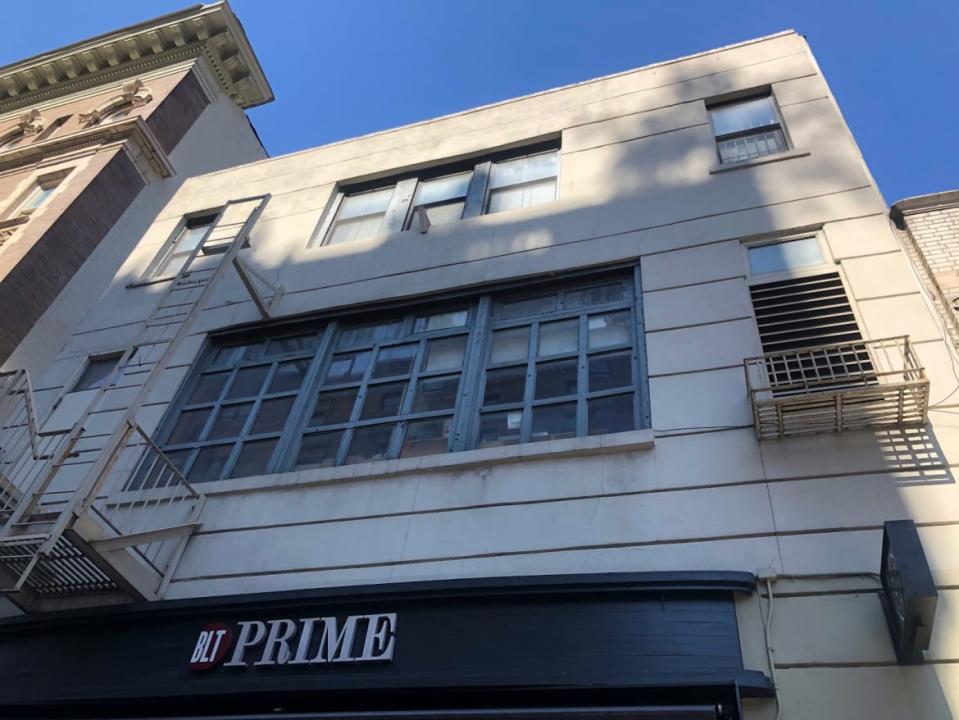
“[Hernan] Cortez says that there are four hundred mosques in Mexico, or that Montezuma is a sultan,” Alan points out. “Those things are there (in the source materials) but we kind of miss them and I think that’s partly because we’ve accepted this idea that Islam has nothing to do with the history of the New World in these early decades, when it very clearly does.” What God’s Shadow does is to simply take historical narratives that already exist in primary documents from contemporary resources of the age and tie them together, giving readers a far more multi-dimensional understanding of our world.
The more traditional tale of Columbus sailing west in search of spices and trade routes, kicking off the Age of Exploration and centuries of European dominance omits the very real influence the Ottomans had. “When you read sources from the period,” Alan continues, “when you read Columbus, you read Martin Luther, [Holy Roman Emperor] Charles V, all of the kind of major canonical figures of European history in this age, they’re obsessed with the Ottomans. That seems highly important. And something we should pay attention to.”
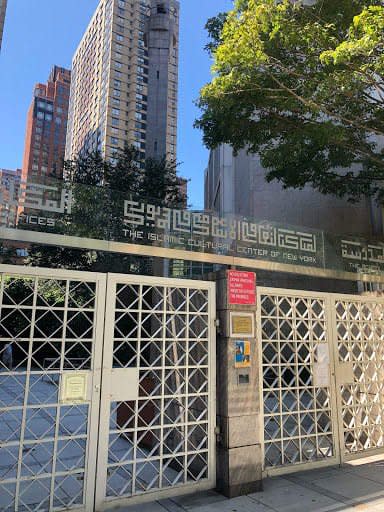
I ask what sparked this book in particular out of the vast sweep of Middle Eastern history. “I came to this project really wanting to focus on the conquest of the Mamluk Empire in 1516-1517, and wanting to think about that as a moment in global history, because it more than doubles, almost triples the size of the (Ottoman) Empire, and puts them into the Indian Ocean world, it gives them Yemen, it puts the Ottomans in Africa, it makes it a majority Muslim empire for the first time in its history. It’s important for all these reasons and we didn’t seem to have a good history of that.”
“So that’s how I started, and Selim leads that, of course, so then it became a larger story about his life, and wanting to think about, ‘okay, all of these world-changing events are happening during his lifetime.’” The year 1492, when Spain defeated Granada to fully expel the Muslim Moors from Iberia and when Columbus sailed west to find the Grand Khan in India; the year 1501, when the Safavid Empire (modern Iran) was established as a Shiite Muslim entity on the Ottomans’ eastern border; the year 1517, when Selim captured Cairo and defeated the Mamluk Empire. These transformative, pivotal years all occurred within Selim’s relatively short life.
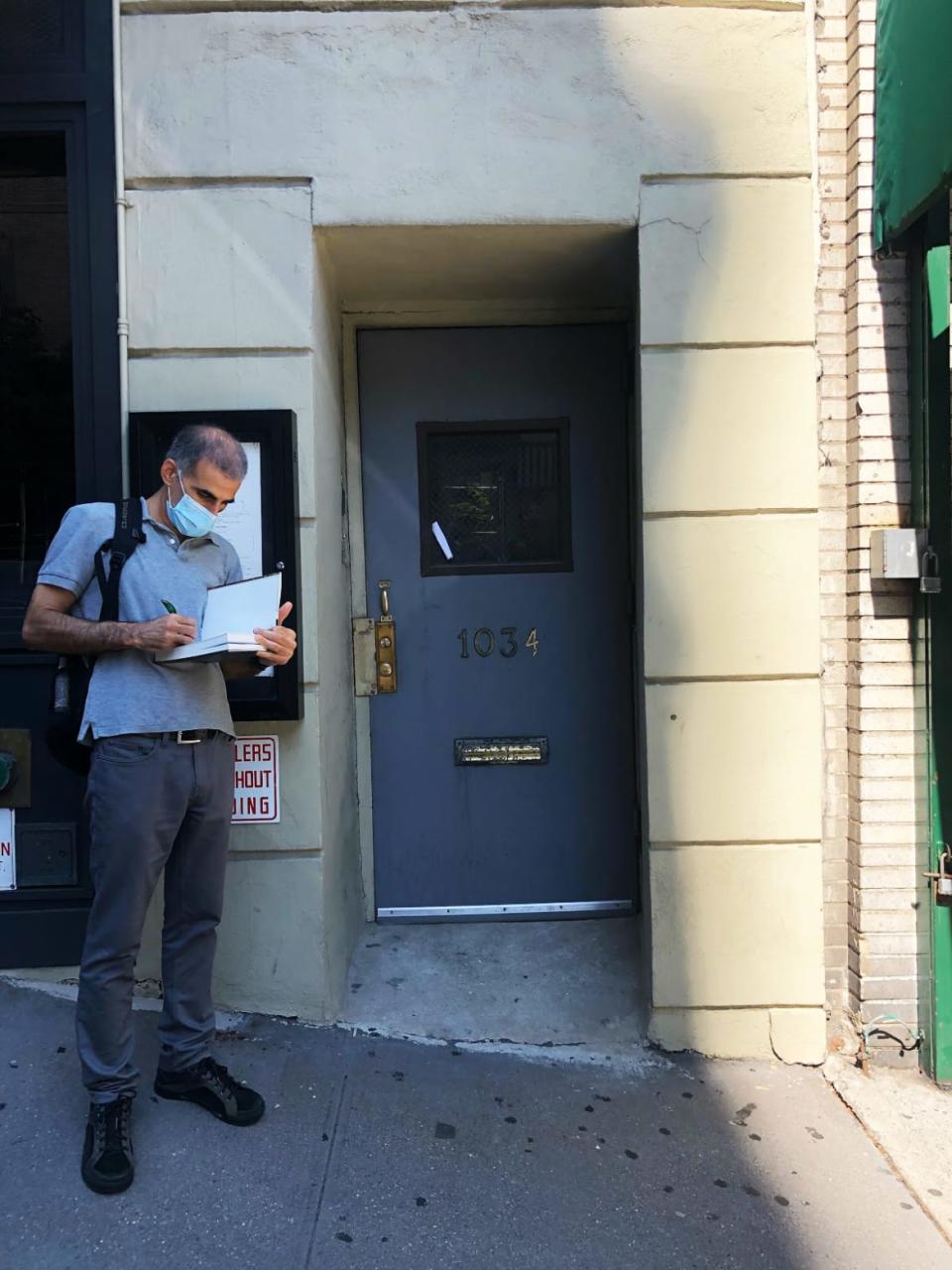
We walk north along Central Park West, leaving Columbus and the year 1492 behind us. We stop at 65th Street and sit on a bench overlooking Holy Trinity Lutheran Church. The church, a Gothic Revival jewel box of granite and limestone, was completed in 1904. We’d come here to discuss Martin Luther, German monk and initiator of the Protestant Reformation. His 95 Theses, written and published in 1517, delineated his position against the then-common practice of “plenary indulgence,” or accepting money for the saving of a person’s soul. The term “Lutheran” began in 1519 as a derogatory label for anyone following the teachings of Martin Luther. He was viewed by the Catholic Church as a heretic and was excommunicated in 1521.
But what does Luther have to do with the Ottomans? It is important to remember that 1517, the year Luther published his 95 Theses, was the same year that Sultan Selim conquered Cairo, tripling the size of his empire. Alan explains of Luther, “He sees them as a message from God. That God is punishing the Christian world with the Ottomans. The Ottomans are in the ascendancy politically, militarily, and that’s because the Catholic church has become corrupt, venal, that the Pope (Leo X at the time) is more interested in worldly things than spiritual things. He cares more about money than souls.”
Luther studied and wrote about Islam extensively. “He’s interested in them for all kinds of reasons. There’s a sort of theological interest in the iconoclasm of Islam, that they don’t make images of humans generally. He’s also interested in the anti-clericalism, that there isn’t a very strict church hierarchy as in the Catholic church. That there are leaders within the community who have different interpretations of the holy books, but that all those can exist together. That there’s not a final pope-like figure.” Ottoman Islam in the early sixteenth century was less about the flesh and more about the soul, “which appeals to him because that’s what he sees as a problem in the Catholic church.”
It was no real coincidence that Luther’s Theses emerged to rock the western Christian world the same year that Selim conquered the Mamluks to rock the Sunni Muslim world. “Luther regularly refers to the Ottomans as the lash of iniquity. That God is whipping Christendom with the Ottomans because of their sins, and it’s only by overcoming sin, only by Christians in their spiritual lives overcoming their own personal sins, that they will then be able to defeat the Ottomans on the ground militarily.”
What’s most surprising, and what Alan makes clear in God’s Shadow, is that westward-bound Europeans for centuries after Luther’s schism were fleeing what they viewed as the two great evils of the Old World: the tyranny of the Catholic Pope and the tyranny of Ottoman Islam. Alan explains that many Protestant refugees throughout the seventeenth century, including those on the Mayflower, make this clear in their writing. “Luther makes that connection initially. He says they’re both evil. Islam and the Pope are both evil. The Pope is worse, though. Protestants later make that connection also, of the Catholic Church and the Ottoman Empire, as the scourges of the Old World that they’re escaping.”
Even John Smith, famous in the tale of Pocahontas, spent time enslaved in the Ottoman Empire beginning in 1602. He fell in love with his owner’s mistress before escaping, and actually named what is now Cape Ann in Massachusetts “Cape Tragabigzanda” after her (it was renamed by King Charles I). And it’s generally left out of the story of the Mayflower that the ship spent years plying trade routes among Ottoman ports in the Mediterranean prior to ferrying the pilgrims to Plymouth in 1620. “One would think that these are, you know, relevant,” Alan shrugs and chuckles behind his mask. “But we’ve cut that out because we don’t want Islam to be a part of the story of America.”
The sun high above us, we rose from the bench and entered Central Park just north of 66th Street, near Tavern on the Green. Cutting across the Mall near Bethesda Terrace, we exited at 72nd Street and continued east until we reached Lexington Avenue. There, at last, we encountered the building which opened this piece. It’s a bland, squat building: the type that’s survived a century more by accident and luck than by preservation. The ground floor is a restaurant, and above that, a second floor which appears to be office or storage space.
The third floor, however, holds signs of life: blinds in each window, closed against the midday August sun. We craned our necks to peer up at them, for this was, for more than 60 years, home to Ertugrul Osman, the last heir to the Ottoman throne to have been born prior to the family’s 1924 expulsion from the new Turkish Republic.
Ertugrul Osman’s former residence, Lexington Avenue
Ertugrul was born in 1912, the grandson of Sultan Abdul Hamid II, who ruled the Empire from 1876 until 1909. These were the waning days of Ottoman glory. Abdul Hamid’s reign was marked by a precipitous loss of territory and influence. Independence was granted to Romania, Serbia, and Montenegro, as well as political autonomy to Bulgaria. Britain began exercising almost complete control over Egypt, Sudan, and Cyprus. Abdul Hamid was deposed in 1909, the last Sultan to exercise any real power before the dynasty was banished altogether.
Born in the tumultuous aftermath of his grandfather’s reign, Ertugrul spent his childhood in the regal comfort of Yildiz and Dolmabahce Palaces overlooking the Bosphorus. At age 10 he was sent away to be educated in Vienna, and it was there, in 1924, that he received word that his family was being expelled from Istanbul. The women had a week to pack and leave; the men had 24 hours. “I don’t understand why the family was given only 24 hours to leave,” his younger brother Bayezid said in a 2015 interview with Turk of America. Ertugrul became the oldest living male in the family in 1994 on the death of his cousin Mehmed Orhan, who was living in France.
If Ertugrul held any grudges against the new rulers in Turkey, he kept to himself about them. He immigrated to the United States in 1933, winding up in Manhattan in 1939. He acquired an apartment on the third floor of a building on Lexington Avenue and settled there in 1945. His first wife, Gulda Twersky, died in 1985. He remarried in 1991, to Zeynep Tarzi, niece to deposed King Amanullah of Afghanistan. She spent her childhood, somewhat ironically, exiled in Istanbul before moving to New York in 1971 to run a fashion company. The couple lived comfortably, with up to a dozen dogs, in Ertugrul’s spacious apartment, where rent-control regulations kept them paying less than $400 a month well into the twenty-first century.
Ertugrul died in 2009 at age 97. With him died something of a final link to a tangible Ottoman past. Eight centuries of Sultans and Caliphs, of wars and conquests, of religious and cultural triumphs on a global scale, ended quietly with his passing. He was given a funeral and honorary burial in Istanbul, next to his grandfather, Sultan Abdul Hamid II. “After him,” Zeynep told the New York Times in 2006, “the tradition of the family will disappear because the rest of the members were born abroad." No one on earth now lives who knows what it was like to run the marble halls of Ottoman palaces, attended by Ottoman servants, bearing the weight of so many centuries only to witness their end.
For his part, Ertugrul never spoke ill of the Turkish Republic and insisted he had no interest in his titles or claims.
“I’m a very practical person,” he told the Times. “Democracy works well in Turkey.” Zeynep, now a widow, endured a protracted legal dispute beginning in 2011 when their Lexington Avenue building was sold and the new owner attempted to force her out. “I paid too much for this building to have you here,” she quoted him as telling her. The notion of a princess in a rent-controlled walk-up made for easy headlines.
Finding the name Osman on the buzzer felt like discovering a piece of Ottoman history right in the middle of New York. We stood outside, musing about Ertugrul’s life story and Zeynep’s rent battle for a while before Alan decided to inscribe a copy of his book to her and slip it through the mail slot. If she does indeed still live there, we hoped that she’d appreciate the gesture.
Alan Mikhail inscribing a book to Zeynep Osman
We continued our walk north along Lexington Avenue, turning east on 96th Street. There, on Third Avenue, sits an unexpected architectural sight: a mosque, modern in its sleek styling, complete with pale green dome and soaring minaret. Tucked in the shadow of a much taller residential skyscraper, the Islamic Cultural Center of New York nevertheless manages to draw the eye. Plans for the Center first began circulating in the 1960s, when New York’s Muslim community met in cramped quarters at 1 Riverside Drive. Decades of delay and planning later, the new complex opened on 3rd Avenue in 1991. The goal was to provide a space for all Muslims, no matter their national heritage, a place to worship, socialize, and study.
It is notable to me that the Center is completely surrounded by tall iron fences and gates, with security cameras at the corners. I couldn’t help but think of St. Patrick’s Old Cathedral down on Mulberry Street, which is surrounded by high brick walls, built in the early nineteenth century to protect against anti-Catholic attacks. I’m reminded of what Alan said about European Protestants fleeing to America to escape “the tyranny of the Pope and the tyranny of the Ottomans.” It feels as if these walls are the tangible legacy of these centuries-old conflicts, brought across the ocean from the Old World to the New.
Islamic Cultural Center of New York, 97th Street Gates
From the Barbary Wars of the early nineteenth century to the ongoing wars in Iraq and Afghanistan, the United States has been fighting the Muslim world for nearly as long as it’s been an independent nation. Alan’s book is part of a larger, more long-term effort to “change the historical narrative of how we got to here.” It does so not only by telling the story of Selim, a sixteenth-century Ottoman Sultan, but by taking his story and making it speak to the stories of his contemporaries in ways seldom otherwise done. The results don’t change: Columbus still sails west, Luther still publishes his 95 Theses, but by reintroducing the Muslim world into the story, the saga becomes more nuanced and whole.
Alan hopes that through understanding can come change. “Changing people’s views of Muslim history” is vital for the future, he says. “Pointing out contributions, whether that be cuisine or math or architecture, I think is important. Just showing how these histories have always been intertwined in both negative and positive ways. We tend to focus on the negative.” We discussed the recent election of the first two Muslim female members of Congress, Ilhan Omar and Rashida Tlaib. “I think people are understanding more and more that Muslims are a part of American society; they always have been. They’re constructive members of society, they’re your doctor, your kid’s teacher at school, your congressperson. I think all of that is good and will only continue.”
As a student of history for much of my adult life, I was pleasantly shocked by how much I learned from Alan’s book, God’s Shadow. I would regularly do a web search while reading just to confirm that whatever seemingly outlandish story he was telling at that particular moment was true. It always was. Alan’s gift for reframing history feels a bit like looking at a world map upside-down. Everything is there and in the correct place; we’ve just grown so accustomed to seeing things from one perspective that it can take some time to process what you’re looking at. His writing feels particularly timely. As he pointed out to me near the end of our walk, Islam is projected to have more adherents than any other religion on Earth by 2070. It’s time to reintroduce them to the narrative of our long collective history.
Get our top stories in your inbox every day. Sign up now!
Daily Beast Membership: Beast Inside goes deeper on the stories that matter to you. Learn more.

 Yahoo News
Yahoo News 
